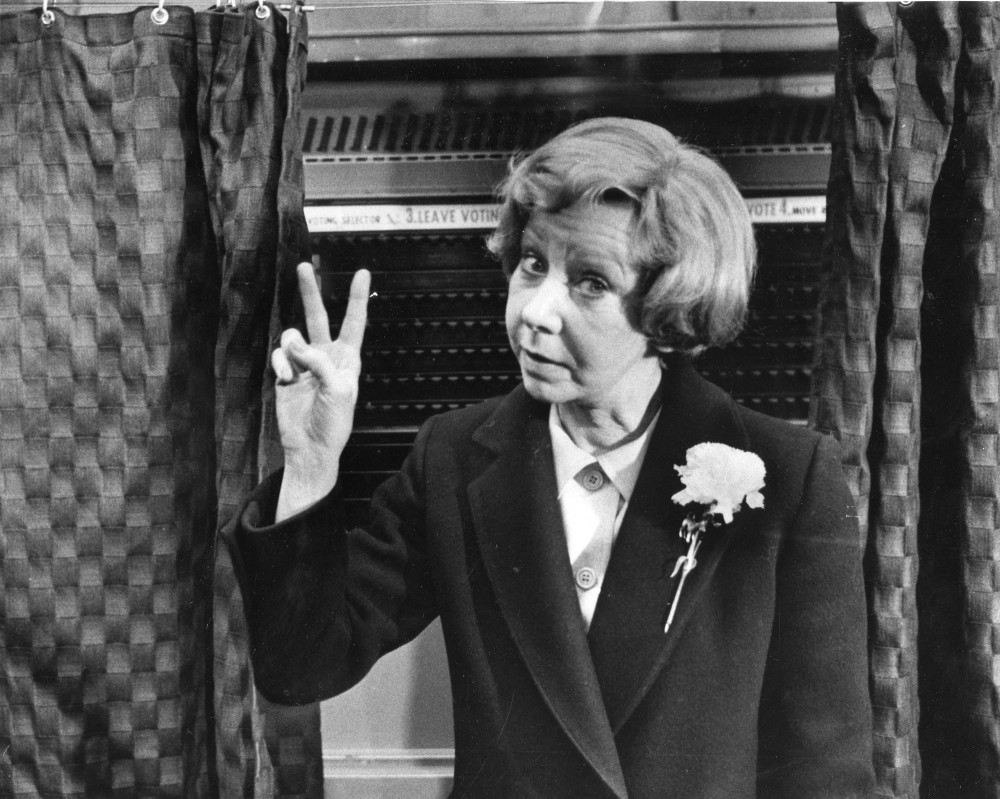EDITORIAL
Chicago Tribune.
Margaret Jane Burke, a debutante from a well-to-do Irish family, was the only pre-med student at Barat College, a proper school for young Catholic women on Chicago’s North Shore.
Around the coffee machine, Janie Burke regaled classmates with caustic stories about the perils of dating the similarly irreverent Bill Byrne. He was a student at Notre Dame, known campuswide as the big, brassy, red-cheeked Clevelander who campaigned for class office by dutifully marching door-to-door. Naked.
In time she would be Chicago’s first, and thus far only, woman mayor. And nothing about her tumultuous journey from Janie Burke to Mayor Jane Byrne would be as remarkable as how she won that job. No, it wasn’t just the fierce blizzards and gridlocked snowplows of political lore; at a public appearance now obscured in the mists of Chicago history, her predecessor found a spectacular way to self-destruct in the face of her onslaught.
Yes, there’s a wonderful yarn leading up to the primary election of Feb. 27, 1979. And after furious voters had dismissed incumbent Mayor Michael Bilandic, the Democratic Party’s new candidate for mayor famously declared, “I beat the whole goddamn machine single-handed!”
Now she leaves us, at age 81, dying Friday after long bouts of ill health.
How Byrne beat the machine is one of Chicago’s epic political tales. She had worked on Sen. John F. Kennedy’s 1960 presidential campaign and met much of his clan. The White House invited her to a 1963 Army-Air Force football game at Soldier Field, where the spunky young widow — Bill Byrne, a Marine flier, had crash-landed in fog near Glenview Naval Air Station in 1959 — impressed Mayor Richard J. Daley. He gave her a job with an antipoverty program, then elevated her to his cabinet as commissioner of sales, weights and measures. In return Byrne rabidly defended Daley; when his minor stroke provoked speculation about possible successors, she called an over-the-top news conference to denounce the “vultures” and “little men of greed” waiting to grab for his power.
After Daley did die in 1976 and Bilandic became mayor, he fired the holdover consumer commissioner. It was a classic case of an old-school pol underestimating a potential and modern foe — even if Byrne had accused him of “greasing” a taxi fare increase.
Even in retreat, Byrne was on the make:
As TV crews taped Byrne cleaning out her City Hall office, she reverently (and painstakingly) packed photos of Daley and of Kennedy with her infant daughter Kathy on his lap. Newsweek correspondent Frank Maier’s wry account in a profile of Byrne for Notre Dame Magazine: “‘A picture of the late mayor and an assassinated president thrown in a box,’ she said — while repacking the pictures over and over for late-arriving photographers. As she walked slowly down a City Hall corridor, one cameraman asked her to pause and look back wistfully. No problem, said Jane.”
She set out to unseat Bilandic, who arrogantly dismissed the notion of her running for mayor: “Mayor of what? Peoria?” Bilandic might have survived his administration’s slow response to two paralyzing snowstorms that dumped 35 inches of snow on Chicago.
But with Byrne rising in the polls, Bilandic panicked at a Valentine’s Day pep rally for precinct captains: He tearfully compared his suffering from Byrne’s campaign attacks to the crucifixion of Jesus Christ and the annihilation of Jews in Nazi Germany.
Chicagoans had had enough of snow and bizarre self-pity from a dead candidate walking. They turned out on a gloriously sunny primary day to nominate Byrne, and later to elect her mayor over an outmatched Republican.
Next came four years of civic excitement and sometimes madcap governance. Byrne set about making peace with what she had called the “evil cabal” of aldermen at City Hall — while not always gently sidelining some of the reformers who had seen her as the living repudiation of her machine patron, Mayor Daley.
So swift was her reconciliation with the very pols she had scorned during her campaign that columnist Mike Royko, then of the Chicago Sun-Times, ridiculed the heir to “Boss” Daley as “Ms. Bossy” — “someone who hopes to be the female version of the late mayor.”
But Byrne didn’t have the discipline to be Daughter of Boss. In her first two years as mayor, she went through four police superintendents, four press secretaries, three city controllers, three budget chiefs and three planning chiefs.
Biographers have suggested that Byrne’s helter-skelter style and shoot-from-the-lip commentary obscured her accomplishments.
She put Chicago on firmer financial footing, tried to do the same for the school system, and moved ahead with expansion of O’Hare International Airport. She withstood an illegal strike by firefighters and a separate strike by transit workers. Refusing to crumble to her picketing employees, she won the gritty admiration of even many cogs in the Democratic machine. Oh, and she ostentatiously, if briefly, moved into the Cabrini-Green public housing development to highlight the devastating crime rate that its residents endured.
Other mayors might want to be remembered solely as builders, or stewards or politicians with heart.
But we knew Jane Byrne before she won the prize title and became “the woman on Five” — peripatetic ruler of the mayoral office suite on the fifth floor of City Hall. We’ll never forget the withering winks, the smart-aleck cracks, the refusal to be an extension of the far less colorful men who had come before.
In that spirit we hope the departing Jane Byrne wouldn’t mind also being remembered the way her second husband, a former City Hall reporter, described her. The mayor of Chicago, Jay McMullen boasted, was “a spitfire” possessed of “fine legs and a great little ass.”
Somewhere, Jane Byrne cackles anew. And winks.














































































































































































































































































































































































